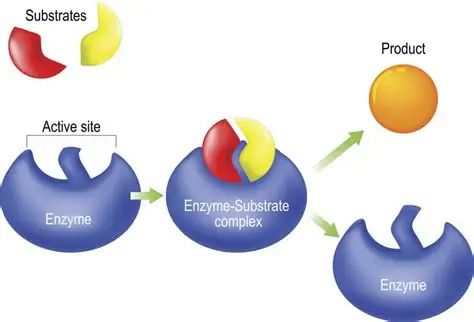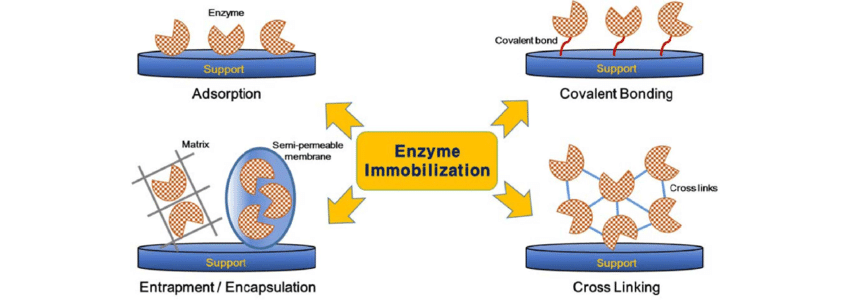Introduction
Enzymes are special proteins that speed up chemical reactions in living organisms. They are essential for life because they allow reactions to happen quickly and efficiently, without the need for extremely high temperatures or other harsh conditions. For example, enzymes help digest the food we eat, copy DNA, and make energy inside cells. Without enzymes, our body’s processes would be too slow to sustain life.
However, enzymes do not always work at the same speed or efficiency. Many different factors can affect how well an enzyme performs. Scientists and industries also use enzymes in controlled settings, like in food production, medicine, and environmental cleanup. To make enzymes more stable and reusable in such applications, they often use a technique called immobilization. This means attaching or trapping enzymes in a solid or semi-solid material so they can be used over and over again.
In this guide, we will explore what affects enzyme action, how immobilized enzymes work, and why they are important. Everything is explained in simple language to help anyone understand.
Table of Contents
What Are Enzymes Action?
Enzymes are biological catalysts, which means they help speed up reactions in cells without being used up themselves. Each enzyme works on a specific molecule called a substrate. The enzyme has a special area called the active site, where the substrate fits like a key in a lock. This fit allows the enzyme to change the substrate into a new product.

Enzymes are usually named after the type of reaction they help with. For example:
- Amylase breaks down starch.
- Protease breaks down proteins.
- Lipase breaks down fats.
Factors Affecting Enzyme Action
Several conditions can affect how fast or efficiently an enzyme works. Here are the main ones:
1. Temperature
Each enzyme works best at a certain temperature, called the optimum temperature. If the temperature is too low, the enzyme and substrate move slowly and do not collide often. If the temperature is too high, the enzyme can lose its shape and become denatured, meaning it no longer works.
For most human enzymes, the optimum temperature is around 37°C, which is body temperature.
2. pH Level
Enzymes also have an optimum pH, which is the acidity or basicity level where they work best. If the pH is too acidic or too basic, the enzyme’s shape can change, affecting its activity.
- For example, pepsin, an enzyme in the stomach, works best at a low pH (around 2).
- Amylase, found in the saliva, works best at a neutral pH (around 7).
3. Substrate Concentration
As the amount of substrate increases, the enzyme works faster—up to a point. This is because more substrate molecules mean more chances for the enzyme to bind and form a product. However, after a certain level, all the enzyme active sites are full, and adding more substrate won’t make a difference. This point is called saturation.
4. Enzyme Concentration
If there are more enzyme molecules, reactions can happen faster—again, up to a point. The rate will increase until there is no more substrate left to bind.
5. Inhibitors
Some molecules can slow down or stop enzyme activity. These are called inhibitors.
- Competitive inhibitors compete with the substrate for the active site.
- Non-competitive inhibitors bind to another part of the enzyme and change its shape so it can’t work properly.
6. Cofactors and Coenzymes
Some enzymes need extra help from non-protein molecules to work. These helpers are called:
- Cofactors (like metal ions such as iron or zinc)
- Coenzymes (like vitamins)
Without these helpers, the enzyme might not function at all.
7. Product Concentration
As the products of the reaction build up, they can sometimes slow down the enzyme’s activity. This is a way for the cell to regulate how much of a product it makes.
What Are Immobilized Enzymes?
Immobilized enzymes are enzymes that are fixed in one place rather than floating freely in a solution. They are often attached to a solid support or trapped in a gel. This makes them easier to reuse and helps control the reaction better.

Immobilized enzymes are widely used in industries like food processing, pharmaceuticals, and environmental science. They are used in everything from making cheese and biofuels to cleaning up oil spills.
Methods of Immobilization
There are several ways to immobilize enzymes. Each method has its benefits and is used depending on the situation.

1. Adsorption
The enzyme sticks to the surface of a solid material, like glass beads or clay. It’s simple and cheap but the enzyme might come off easily.
2. Covalent Bonding
The enzyme is chemically bonded to the support. This method is more stable but can sometimes change the enzyme’s shape.
3. Entrapment
The enzyme is trapped inside a gel or fiber, like calcium alginate. The substrate and products can move in and out, but the enzyme stays put.
4. Encapsulation
The enzyme is enclosed in a tiny capsule or membrane. This keeps it safe from the environment but may slow the reaction a bit.
5. Cross-linking
Enzymes are linked together in a network using special chemicals. This makes a strong structure but can be hard to control.
Advantages of Immobilized Enzymes
Using immobilized enzymes offers many benefits, especially in large-scale operations:
1. Reusability
The enzyme can be used again and again, saving money and reducing waste.
2. Stability
Immobilized enzymes are often more stable than free enzymes. They can resist changes in temperature and pH better.
3. Easier Separation
After the reaction, it’s easier to separate the enzyme from the product. This is especially useful in food and medicine industries where purity is important.
4. Continuous Use
In industrial setups, immobilized enzymes can be used in continuous flow systems, where the substrate flows through and the product comes out the other side.
5. Less Contamination
Since the enzyme doesn’t mix into the final product, there’s less chance of contamination.
Disadvantages of Immobilized Enzymes
While they are useful, immobilized enzymes also have some downsides:
1. Cost
The materials and process used to immobilize enzymes can be expensive.
2. Reduced Activity
Sometimes the enzyme’s shape changes slightly during immobilization, making it less active.
3. Diffusion Limits
If the enzyme is deep inside a gel or capsule, it might be harder for the substrate to reach it or for the product to leave.
4. Not Suitable for All Enzymes
Some enzymes don’t work well when immobilized, especially if they need to change shape to function properly.
Applications of Immobilized Enzymes
Immobilized enzymes are used in many areas of life and industry. Here are some examples:
1. Food Industry
- Making lactose-free milk using immobilized lactase.
- Producing sweeteners like glucose and fructose.
- Brewing and baking processes.
2. Pharmaceutical Industry
- Making antibiotics and vitamins.
- Developing diagnostic tests.
3. Environmental Uses
- Breaking down pollutants in wastewater.
- Cleaning up oil spills using enzyme-coated materials.
4. Biofuels and Energy
Producing bioethanol and biodiesel using enzymes that break down plant materials.
5. Textile and Paper Industry
- Softening fabrics.
- Breaking down starches and other materials in paper processing.
Conclusion
Enzymes are amazing biological tools that help speed up the chemical reactions our bodies and industries rely on. Many factors, such as temperature, pH, and inhibitors, can affect how well an enzyme works. To make enzymes more stable, cost-effective, and easier to use repeatedly, scientists developed immobilization techniques. These immobilized enzymes are now used all over the world in fields ranging from food and medicine to energy and environmental protection.
By understanding both how enzymes work and how they can be used in an immobilized form, we open the door to more efficient, sustainable, and innovative technologies for the future.
FREQUENTLY ASKED QUESTIONS
What is the optimum temperature for enzyme activity?
The optimum temperature is the specific temperature at which an enzyme works best. For human enzymes, this is typically around 37°C, which is our normal body temperature.
Why do enzymes stop working at high temperatures?
High temperatures can cause enzymes to lose their shape—a process known as denaturation. Once denatured, the enzyme’s active site no longer fits the substrate, so it can’t function.
What is meant by enzyme saturation?
Saturation occurs when all of the enzyme molecules are fully occupied with substrate. Adding more substrate won’t increase the rate of reaction because there are no free enzymes to bind with.
Related Articles




